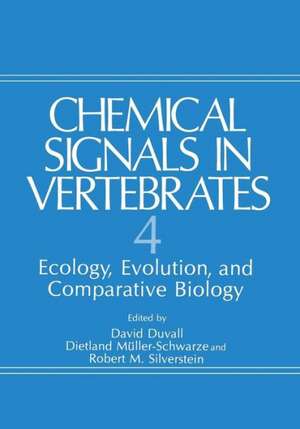Chemical Signals in Vertebrates 4: Ecology, Evolution, and Comparative Biology
Autor David Duvall, Dietland Müller-Schwarze, Robert M. Silversteinen Limba Engleză Paperback – 27 sep 2011
Preț: 671.97 lei
Preț vechi: 790.56 lei
-15% Nou
Puncte Express: 1008
Preț estimativ în valută:
128.58€ • 134.61$ • 106.39£
128.58€ • 134.61$ • 106.39£
Carte tipărită la comandă
Livrare economică 05-19 aprilie
Preluare comenzi: 021 569.72.76
Specificații
ISBN-13: 9781461293101
ISBN-10: 1461293103
Pagini: 760
Ilustrații: 754 p. 112 illus.
Dimensiuni: 178 x 254 x 40 mm
Greutate: 1.29 kg
Ediția:Softcover reprint of the original 1st ed. 1986
Editura: Springer Us
Colecția Springer
Locul publicării:New York, NY, United States
ISBN-10: 1461293103
Pagini: 760
Ilustrații: 754 p. 112 illus.
Dimensiuni: 178 x 254 x 40 mm
Greutate: 1.29 kg
Ediția:Softcover reprint of the original 1st ed. 1986
Editura: Springer Us
Colecția Springer
Locul publicării:New York, NY, United States
Public țintă
ResearchCuprins
One: Some General Considerations.- A Quarter of a Century of Studies of Chemical Communication in Vertebrates.- The Tetrapod Epidermis: A System Protoadapted as a Semiochemical Source.- Mammalian Semiochemistry: Issues and Futures, with some Examples from a Study of Chemical Signalling in Cattle.- Motor Patterns Dedicated to Sensory Functions.- Two: Chemistry.- Chemical Control of Feeding in Herbivorous and Carnivorous Fish.- Characteristics of Earthworm Washings Detected by the Vomeronasal System of Snakes.- Chemical and Biological Investigations of Female Mouse Pheromones.- Behavioral Function and Chemistry of Volatiles From Feces and Anal Secretions of House Mice, Mus musculus — A Preliminary Report.- Three: Fishes.- The Evolution of Chemical Alarm Signals in Fishes.- Fish Reproductive Pheromones.- Chemosensory Orientation Mechanisms of Fish.- Release of Spawning Pheromone(s) by Naturally-ovulated and Prostaglandin-injected, Nonovulated Female Goldfish.- The Structural and Functional Relationships Between Olfactory and Reproductive Systems From Birth to Old Age in Fish.- Four: Amphibians.- The Evolution of Salamander Courtship Pheromones.- Pheromonal Markers as Territorial Advertisement By Terrestrial Salamanders.- The Recognition and Use of Chemical Signals By a Nesting Salamander.- Evolution of Chemical Signals as a Premating Isolating Mechanism in a Complex of Terrestrial Salamanders.- Chemical Ecology of Kin Recognition in Anuran Amphibians.- Five: Reptiles.- Pheromones and Reproduction in Garter Snakes.- The Role of Pheromone Trails in the Sociobiology Of Snakes.- Pheromone Mimicry in Garter Snakes.- Initial Den Location by Neonatal Prairie Rattlesnakes: Functions, Causes, and Natural History in Chemical Ecology.- Exploratory Tongue Flicking by Green IguanasIn Laboratory and Field.- Lizard Pheromones: Behavioral Resnonses and Adaptive Significance in Skinks of the Genus Eumeces.- Chemoreception in the Homing and Orientation Behavior of Amphibians and Reptiles, with Special Reference To Sea Turtles.- Six: Birds.- The Ecological and Evolutionary Challenges Of Procellariiform Olfaction.- Chemoreception and the Selection of Green Plants as Nest Fumigants by Starlings.- Seven: Mammals.- Economic Consequences of Scent Marking in Mammalian Territoriality.- Chemical Signals and Kin Recognition in Spiny Mice (Acomys cahirinus).- Genetic Basis for Individual Discriminations: The Major Histocompatibility Complex of the Mouse.- The Suppression of Ovarian Function By Chemosignals.- The Evolutionary Significance of the Olfactory Block to Pregnancy.- Puberty-Influencing Chemosignals in House Mice: Ecological and Evolutionary Considerations.- The Puberty Delaying Pheromone of the House Mouse: Field Data and a New Evolutionary Perspective.- Effects of Genotype, Social Interaction, and Testosterone on Esterases in Male Mouse Urine.- The Mammalian Vomeronasal System: Its Role in Learning and Social Behaviors.- Olfactory Communication Among Rats: Information Concerning Distant Diets.- Alarm Chemosignals in a Meriones unguiculatus: Prey-Predator Interactions.- Avoidance Response of Pocket Gophers (Thomomys talpoides) to Mustelid Anal Gland Compounds.- The Comparative Responses of Mice and Voles To Conspecific and Heterospecific Odors in The Field — A Lesson in Social Behavior.- Morphometric Patterns Among Microtine Rodents. I. Sexual Selection Suggested by Relative Scent Gland Development in Representative Voles (Microtus).- Female-induced Delay of Puberty in Bank Vole and European Pine Vole Females.- Familial Chemosignals Interfere withReproductive Activation in Female Pine Voles, Microtus pinetorum.- Odor Images: Responses of Beaver to Castoreum Fractions.- Scent-marking in Pikas (Ochotona princeps): Test of a Breeding-facilitation Hypothesis.- Histology and Gross Morphology of the Sexually Dimorphic Sternal Gland in the North American Opossum, Didelphis virginiana Kerr.- Chemical Communication in Gray Short-tailed Opossums (Monodelphis domestica) with Comparisons to other Marsupials and with Reference to Monotremes.- Observations on Chemical Communication and its Glandular Sources in Selected Insectivora.- Plantar Glands in North American Mustelidae.- The Marking Behavior of Male Przewalski’s Horses.- Chemical Communication Among Asian Elephants.- Territorial Scent Marking by Two Sympatric Lemur Species.- Chemical Signals in Callitrichid Monkeys — A Comparative Review.- Cross-cultural Studies of Taste and Smell Perception.- Author Index.- Subject And Taxonomic Index.















